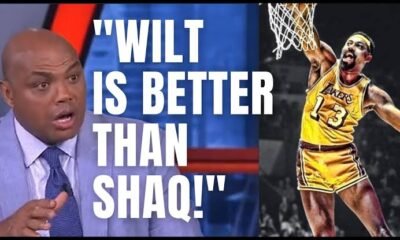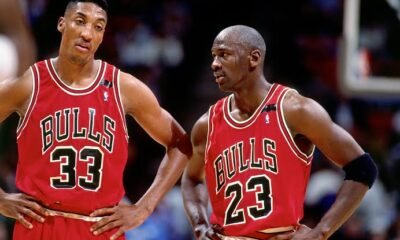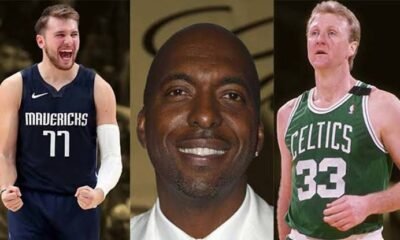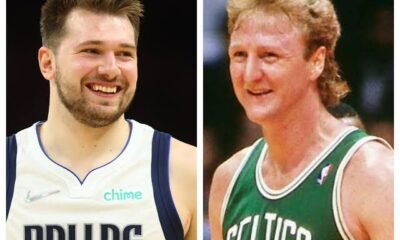Basket Ball
Analyzing the Greats: Was Wilt Chamberlain or Larry Bird the Superior Shooter?**
**Analyzing the Greats: Was Wilt Chamberlain or Larry Bird the Superior Shooter?**
In the realm of basketball, comparing legends from different eras often sparks lively debates. One such debate centers around two towering figures: Wilt Chamberlain and Larry Bird. While both players have left indelible marks on the sport, their styles of play and skill sets were vastly different. A key area of comparison is their shooting prowess. Was Wilt Chamberlain or Larry Bird the superior shooter?
**Wilt Chamberlain: The Dominant Force in the Paint**
Wilt Chamberlain, known as “Wilt the Stilt” and “The Big Dipper,” was a dominant force in the paint during his career from 1959 to 1973. Standing at 7’1″, Chamberlain used his size, strength, and athleticism to overpower opponents. His scoring ability was unparalleled, highlighted by his 100-point game in 1962—a record that still stands today. Chamberlain’s career field goal percentage of 54% is a testament to his efficiency around the basket.
However, Chamberlain’s shooting range was primarily limited to close-range shots and dunks. The majority of his points came from within a few feet of the basket, where he utilized his height advantage to score over defenders. While his shooting percentage was high, it was largely due to the nature of his shots rather than his shooting technique or range. Chamberlain was not known for his outside shooting, and his free-throw shooting percentage of 51.1% was a notable weakness in his game.
**Larry Bird: The Versatile Scorer and Sharpshooter**
Larry Bird, who played from 1979 to 1992, brought a different kind of brilliance to the court. Known for his exceptional basketball IQ, versatility, and competitive spirit, Bird was a prolific scorer from all areas of the floor. Standing at 6’9″, he had the ability to shoot from long range, mid-range, and close to the basket, making him a versatile threat.
Bird’s career field goal percentage was 49.6%, with a three-point shooting percentage of 37.6%. He was also a reliable free-throw shooter, boasting a career average of 88.6%. Bird’s shooting form, combined with his ability to create his own shot and score under pressure, made him one of the most feared shooters in the game. His clutch performances in key moments further solidified his reputation as a sharpshooter.
**Comparing Shooting Styles and Impact**
When comparing Chamberlain and Bird as shooters, it’s essential to consider their distinct styles and roles on their respective teams. Chamberlain’s shooting was characterized by dominance in the paint and efficiency in scoring high-percentage shots close to the basket. His physicality and scoring ability made him an unstoppable force inside, but his shooting range was limited.
Bird, on the other hand, was a versatile scorer with a remarkable shooting touch from various distances. His ability to shoot from beyond the arc, mid-range, and the free-throw line made him a more well-rounded shooter. Bird’s shooting prowess extended to clutch situations, where he consistently delivered in critical moments.
**Statistical Analysis**
To further analyze their shooting abilities, a closer look at their career statistics provides insight. Chamberlain’s career points per game average of 30.1 is impressive, but his shooting efficiency was largely due to his proximity to the basket. Bird’s career points per game average of 24.3 is slightly lower, but his shooting versatility and efficiency from all areas of the floor highlight his superior shooting skills.
Bird’s three-point shooting percentage of 37.6% is particularly noteworthy, given the era in which he played. The three-point line was introduced to the NBA in 1979, and Bird quickly adapted, becoming one of the league’s first great three-point shooters. In contrast, Chamberlain’s era did not feature the three-point line, and his game was not oriented towards long-range shooting.
**Impact on the Game**
Both Chamberlain and Bird had significant impacts on the game of basketball, but their contributions were different. Chamberlain’s dominance in the paint changed the way the game was played, leading to rule changes such as widening the lane to limit his effectiveness. His scoring records and physical presence left a lasting legacy.
Bird’s impact on the game extended beyond his scoring ability. His versatility, shooting range, and competitive nature helped elevate the NBA’s popularity in the 1980s. Bird’s rivalry with Magic Johnson and his role in the Boston Celtics’ success during that era contributed to the league’s growth and increased fan interest.
**Conclusion**
In conclusion, while Wilt Chamberlain was an unparalleled force in the paint and a dominant scorer, Larry Bird’s shooting versatility and range make him the superior shooter. Bird’s ability to score from various distances, combined with his clutch performances and high free-throw percentage, highlight his exceptional shooting skills. Chamberlain’s efficiency around the basket was unmatched, but Bird’s well-rounded shooting game and impact on the evolution of basketball shooting are noteworthy.
Ultimately, the comparison between Chamberlain and Bird as shooters underscores the diversity of greatness in basketball. Both players excelled in their respective styles, leaving legacies that continue to influence the sport today.
-

 Basket Ball7 months ago
Basket Ball7 months agoNBA Legends Explain Why Wilt Chamberlain Was Better Than Everybody. Take a look at what he said ⬇️⬇️
-

 Football2 months ago
Football2 months agoTransfer-News: Trauriger Abschied, da Kolbs Top-Stürmer Wechsel zustimmt…
-

 Uncategorized5 months ago
Uncategorized5 months agoWishing Anthony Delon a Happy Birthday: Celebrate with Him Today! 🎂
-

 Uncategorized6 months ago
Uncategorized6 months ago**Hollywood Icon Robert Redford Passes Away at 87
-

 Uncategorized7 months ago
Uncategorized7 months agoPat Metheny gives his explanation for retiring: “I know this would hurt my fans, but I have no other choice.”
-

 Uncategorized7 months ago
Uncategorized7 months agoAgnetha Fältskog explains why she decided to retire: “I have no choice but to do this, even though I know it will upset my fans.”
-

 Uncategorized7 months ago
Uncategorized7 months agoI bid you farewell: Pat Metheny declares his retirement date because of…
-

 Uncategorized5 months ago
Uncategorized5 months agoJoyful News: Anthony Delon and Sveva Alviti Announce They’re Expecting Their First Baby—Congratulations to the Happy Couple!












